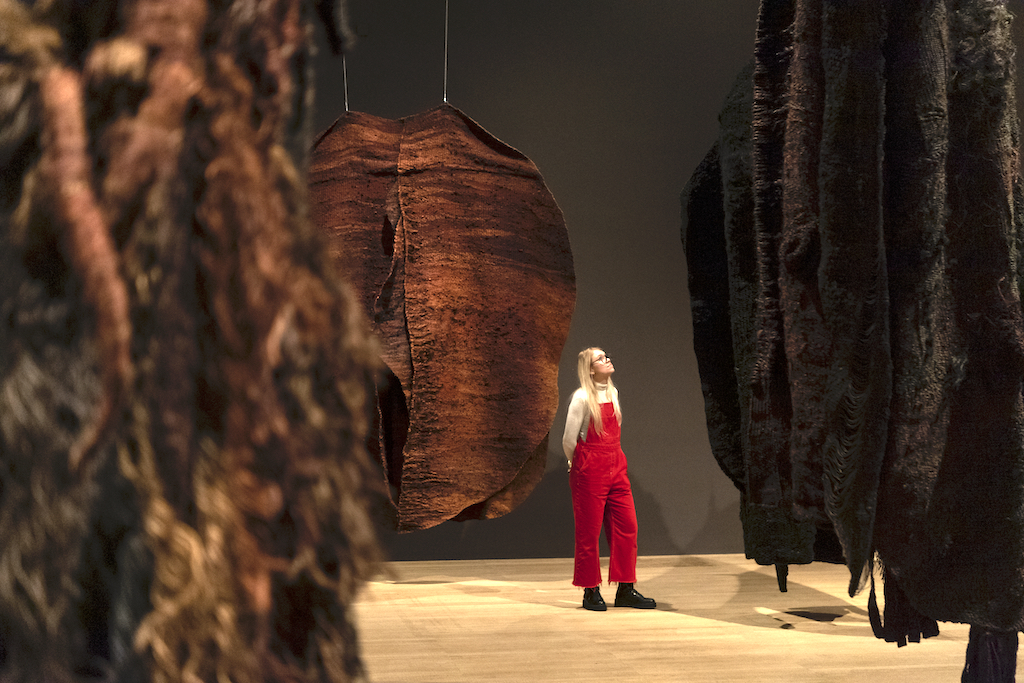Magdalena Abakanowicz: A Pioneer in Fiber Art and Sculpture

Magdalena Abakanowicz: A Pioneer in Fiber Art and Sculpture
Introduction
Magdalena Abakanowicz was a Polish-born woman who sculptor using fibers and finished the work with a polish. Magdalena Abakanowicz’s works ranging from social realism and welded sculpture to abstraction can be considered as her contribution to the new dimension of contemporary art.
Early Life and Education
Magdalena Abakanowicz was born on June 20, 1930, in the village of Falenty located in Poland which had suffered from war and political changes. Cooke highlights Wojnarowska’s suffering that resulted from World War II and later on the communism in Poland affected her artistic outlook. Abakanowicz took a course at the Academy of Fine Arts in Warsaw before concentrating in textile and sculpture studies after exploring painting as well.
The Birth of Fiber Art
The 1960s: A Decade of Innovation
Since the beginning of the 1960s Magdalena Abakanowicz began to work with woven fibers what turned out later to be called her “Abakans. ” These are monumental sculptural textiles which throughout the evolution of the works of the artist became semiotic, aesthetics and an experiment in defining the borderline between art and craft.
- Materials: She stated in evidence that she employed organic materials, which denotes, sisal, hemp, and wool were used in sculpture making by her.
- Techniques: In her creations, she used such methods as weaving, knotting, and braiding to make the pieces of art.
- Themes: Her Abakans often featured organic, ambiguous forms that suggested growth and transformation.
Recognition and Impact
It is necessary to admit that the work of magdalena abakanowicz artwork had a radical orientation and received considerable attention at the international level. Recognized internationally for her sculptures she exhibited her works in museums of contemporary art of Biennale de Paris and São Paulo Art Biennial where she won many prizes.
Major Works and Installations
Abakans: The Fiber Revolution
The Abakans remain some of Abakanowicz’s most celebrated works. These sculptures are realized in forms that are open to interpretation, and many are touchable. Making the reception based on the stimulating sense of touch, collectively known as the haptic sense These realizations in the form of the Abakans were placed in installations where the viewers could touch and interact with the work.
Outdoor Installations
To add to the fiber art, Magdalena Abakanowicz developed many large sculpture installations, which adorned the outdoors. Such installations included anthropomorphic figures created from metals, such as bronze; wood, and stones.
- Agora (2006): Some of the works of Serrano include, One of her most famous installations Agora which entails 106 headless, castiron figures and is permanently installed in Chicago’s Grant Park.
- The Crowd (1986-1990): This installment includes a set of eight life-sized life-cast figures – This is evident since the sculpture focuses on the two aspects of Individual identity and the mass.
Textile Sculptures
Except for the Abakans, other textile sculptures are also defined by Magdalena Abakanowicz as El Lissitzky’s Quadrilateral Cloth, Cloth, Lattice, Cloth Construction, and Cylinder Construction, among others. Many of these works depict elements of nature, change, and the role of humanity.
| Artwork | Year | Description |
|---|---|---|
| Abakan Red | 1969 | A large, hanging textile sculpture with organic, flowing forms |
| Backs | 1976-1982 | A series of 80 human-like figures made from burlap and resin, representing vulnerability and resilience |
| Embryology | 1978-1980 | Embryology 1978-1980 It comprises formless, organic installations that are symbolic of the stages of embryonic growth. |
Abakanowicz at Tate Modern
Magdalena Abakanowicz Tate Exhibition
Magdalena Abakanowicz Tate‘s exhibition offered a survey of the most important. Famous works were dedicated to the artist’s experience. The exhibition addressed the audience to the fact of the material experiment as well as the contribution that. She made it to the sphere of contemporary sculpture.
Magdalena Abakanowicz Tate Review
The formal Magdalena Abakanowicz Tate review applauded the exhibition for its offer which provided the viewer with an induction into Abakanowicz’s artworks. Contemporaries and critics were grabbed by the intensity and the vigorous feeling of her sculptures.
Magdalena Abakanowicz on View
At this time, some of Magdalena Abakanowicz’s pieces of art are exhibited in museums and galleries all over the world. So, her works go on to intrigue the public with their strong shapes and sensitive subject matters.
Legacy and Influence
The great legacy of Magdalena Abakanowicz is her extraordinary contribution to sculpture. Fiber art most of which has been copied by artists of the later generation as the world still analyzes. The works of Abakanowicz for their outstanding emotional content.
Influence on Contemporary Art
The late Abakanowicz has widely inspired many contemporary artists due to her outstanding application of textiles as sculptural material. One of the characteristics that highlights her work is the fact that. So, she was able to make deep artistic messages out of very basic materials.
Awards and Recognition
Throughout her career, Magdalena Abakanowicz received numerous awards and honors, including:
- The International Art Critics Association Prize (1965)
- The Herder Prize (1979)
- The Commander’s Cross with Star of the Order of Polonia Restituta (2001)
FAQs
Who was Magdalena Abakanowicz?
Magdalena Abakanowicz was a Polish sculptor. Fiber artists used textile material in a new and interesting way that humans had never seen before. Organic forms and ambiguity of shapes as well as such subjects as nature. So, change and the existence of people were characteristic of her creations.
What are Abakans?
The works named Abakans are a group of monumental sculptures in three dimensions. Which are made by weaving and belonged to Magdalena Abakanowicz during the 1960s. Sculptures such as these questioned conventional ideas of the art form and breathed fresh air into postmodern art.
Where can I see Magdalena Abakanowicz’s works?
Some of the art pieces that were produced by Magdalena Abakanowicz are in different museums and galleries globally. So, some of its famous works include ‘Agora’ installed in Chicago, ’s Grant Park; and pieces in Tate Modern, London.
What materials did Magdalena Abakanowicz use in her sculptures?
So, the main and preferred materials used by Magdalena Abakanowicz in her sculptures include sisal, hemp, wool, bronze wood, and stone. An important feature of her work is the ability to successfully apply natural materials creatively.
How did Magdalena Abakanowicz influence contemporary art?
Among them, numerous contemporary artists benefit from the founder of the Textile Department of the School of Form. So, Magdalena Abakanowicz experimented with the use of textiles in sculpture. Her aptness to create meaning from mundane objects continues to demonstrate a significant aspect of her work.
Conclusion
Magdalena Abakanowicz remains an exceptional artist who aimed to provoke people’s thoughts and affect their perception of the world. While continuing the tradition of the sculptural approach to textiles and her strong, expressive themes. So, she has earned her rightful place among the most important artists of the twentieth century. While her works continue to be displayed in such institutions. Abakanowicz’s art continues to present the possibilities for transformation to the next generations.






